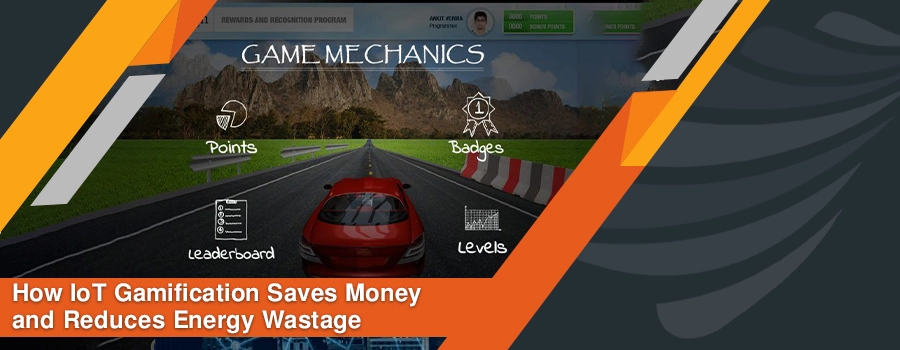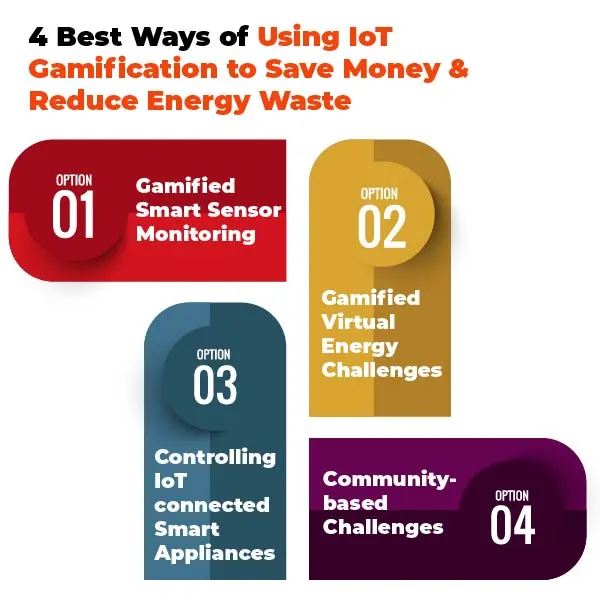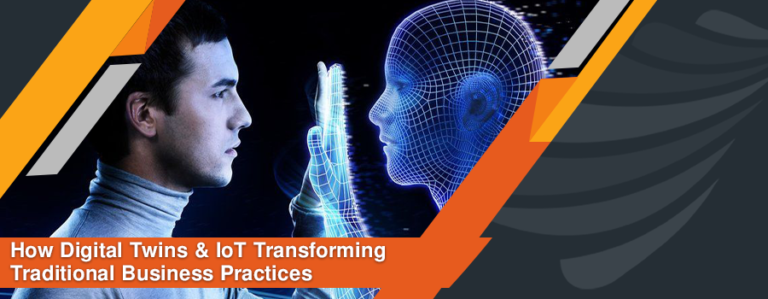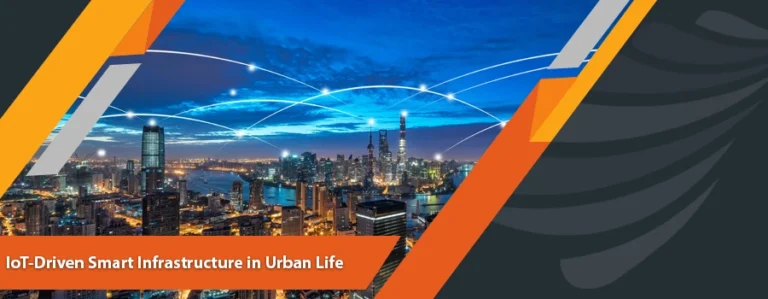We all strive to adopt sustainable strategies, save money, reduce energy waste, and achieve a secure, comfortable, and enjoyable life. With the convergence of the Internet of Things (IoT) and gamification, we get a transformative force to achieve these goals. This dynamic duo crosses conventional approaches and engages us in an interactive journey where energy-saving actions become a rewarding game.
Let’s get ready to unravel how IoT gamification guides us toward adopting energy efficiency practices and dive into the future of financial saving and sustainability.
What is IoT Gamification?
IoT gamification is a strategic combination of gamification principles and the Internet of Things (IoT) to develop incentivized and interactive experiences. Integrating gamification elements like rewards, challenges, and points into IoT applications to motivate users, enhance engagement, and encourage users.
The combination of the capabilities of interconnected devices and motivational aspects of games and IoT gamification makes interaction with IoT devices more enjoyable and promotes a better understanding of users. This method frequently accomplishes objectives such as enhanced user contact with IoT devices, skill development, and reduced energy wastage.
How IoT Gamification Works?
IoT gamification works by incorporating the following operations:
1. Integration of IoT devices
The process starts with integrating IoT devices equipped with sensors and actuators. These devices collect real-time data and help evaluate human behavior, activities, and environmental factors.
2. Data Processing
IoT devices collect and transmit real-time data to the cloud platform or central system. This data could include user interaction, environmental conditions, and energy consumption information.
3. Introduction of Gamification Elements
Gamification elements like points, rewards, levels, and challenges are incorporated with the IoT applications. The purpose is to strategically align with specific goals and enhance user engagement.
4. User Engagement and Interaction
Users interact with IoT devices linked with gamified applications. As they follow rules and guidelines while engaging with IoT devices, they earn points and rewards based on how well they perform activities or follow guidelines. This also gives a sense of responsibility and achievement among users.
5. Real-Time Feedback
The gamified IoT applications provide real-time feedback to users, allowing them to understand the better way of using devices and the impact of their behavior, like saving money, conserving energy, and reducing waste.
6. Community and Social Interaction
Social features are often integrated, allowing users to share achievements, collaborate with others, or participate in community challenges. This social aspect enhances engagement and fosters community around the gamified IoT ecosystem.
7. Data Visualization
The IoT-generated data is translated into visually accessible information with the gamified interface. It helps users interpret and comprehend data more efficiently, leading to a better user experience.
4 Best Ways of Using IoT Gamification to Save Money and Reduce Energy Waste
1. Gamified Smart Sensor Monitoring
HIVE is a smart sensor monitoring and management solution. Users can control various IoT sensors and devices with it. They can see sensors’ health and activity and control them via HIVE. When gaming elements are integrated into HIVE, users can become more interested in saving electricity consumption and earning points. The app can show challenges like turning off unnecessary electric appliances, shifting to DC fans, and using solar panels. When users complete these tasks, they earn points and rewards. These points give them several discounts on their next purchases, and they gain social recognition and become responsible citizens.
2. Gamified Virtual Energy Challenges
Developing simulated scenarios is the best way to engage users in optimizing energy usage. In a virtual gaming environment, they may learn to choose the best lighting and heating system that saves money and reduces energy consumption. By adopting successful energy-efficient choices, they earn points and reach new levels. This educates users and motivates them to apply the learned energy-saving strategies in real homes.
3. Controlling IoT connected Smart Appliances
Users can turn their daily use of IoT-connected smart appliances into a gamified energy-saving experience with IoT gamification. They can get real-time data on their smart devices related to energy consumption, wastage, and efficiency. They can also get feedback and recommendations to reduce usage and earn rewards and points. Such gamification elements encourage them to incorporate suggestions, make conscious choices, and earn rewards.
4. Community-based Challenges
The IoT gamification applications can also contain social communities and groups to encourage people to play collectively, share scores with each other, and collaborate. Users can work together or compete to complete energy-saving activities, such as cutting back on electricity use during peak hours. By offering incentives depending on the performance of their group, participants are incentivized to work together toward sustainability. The community component of the gamified experience is further strengthened by social acknowledgment and shared accomplishments.
Use Case of IoT Gamification to Reduce Energy Waste and Electricity Bills
IoT gamification has been employed in an unprecedented move in a social housing pilot project to combat energy waste and promote sustainable living. A gamified mobile app called ‘Energy Cat: The House of Tomorrow’ was developed for the project; it educated users on energy efficiency and rewarded them for eco-friendly behaviors. This app was designed to interact with smart meters installed in the pilot houses, establishing an interface that showed real-time power usage information and incorporated game mechanics into it.
Using the Living Lab methodology ensured tenants actively participated in the design process, guaranteeing maximum user acceptance and substantial energy savings. Data from the smart meters, which recorded high-frequency electricity consumption, were sent to one central data hub. Users are encouraged to create profiles and link their smart meter devices with the Energy Cat app so they can track home energy usage; this includes a house customization mode used for virtual designing and retrofitting that enhances improved energy efficiency.
AI-controlled energy cats and humans inhabit the virtual world of Energy Cats, where players aim to reduce household energy consumption and earn valuable energy points. These points unlock rewards and upgrades, from storage items to energy-saving items such as insulation and efficiency appliances. The game’s immersive narrative features mission modes that teach players energy efficiency practices, including challenges of optimizing heat, reducing water consumption, and mechanical energy saving, including use.
Crucially, gaming is not just a virtual experience. The energy savings translate into in-game improvements when interacting with smart meter data. Players are rewarded with additional bonuses for significant discounts, creating a direct link between sustainable practices and tangible benefits. Users can also communicate socially within the app, creating a sense of community by sharing progress, community challenges, and friendly competitions with neighbors.
This innovative use of IoT games in the Energy Cat project is a holistic approach to reducing energy waste, saving money, and promoting sustainable practices Through real-time analytics on a mixture of fun games and social interaction.
Future Aspects of IoT Gamification
The promise of IoT gamification in the future is a radical change in how people use technology to solve environmental problems. Personalized experiences will become increasingly important as technology develops, with gamification always changing to accommodate user preferences and habits. Integrating gamified experiences with cutting-edge technology like blockchain and augmented reality will improve security, transparency, and the immersive experience overall. Artificial intelligence-driven adaptability and cross-platform connectivity guarantee users a smooth and consistently engaging experience across multiple devices.
Collaboration and social impact will grow, promoting an international community centered around sustainable practices. Gamification may impact environmental awareness and holistic sustainability by encouraging a wider range of eco-friendly behaviors in addition to energy conservation. Furthermore, gamification has the potential to be a major factor in smart cities by encouraging public participation in programs aimed at promoting urban sustainability.
There will be a greater emphasis on educational programs on gamified platforms, informing users about how their decisions affect the environment and encouraging sustainable lifestyles. Governments may incorporate gamification into regulatory frameworks more frequently to motivate citizens to reach energy efficiency targets and to better connect their efforts with the larger environmental objectives. IoT gamification can transform sustainable living by delivering interesting, instructive, and socially conscious experiences beyond individual acts and help create a more energy- and environmentally-conscious world.
Final Thoughts
IoT gamification is a visionary solution that can revolutionize our approach to energy consumption and reduce electricity bills. With IoT gamification, you can transform your energy-saving efforts into rewarding games. IoT-based games guide, educate, and help users reduce energy waste and save energy costs. Also, users automatically engage in the adoption of sustainable practices. We can say that IoT gamification is not a trend but a powerful tool that cultivates a sense of responsibility among citizens toward economic development and a greener future.





